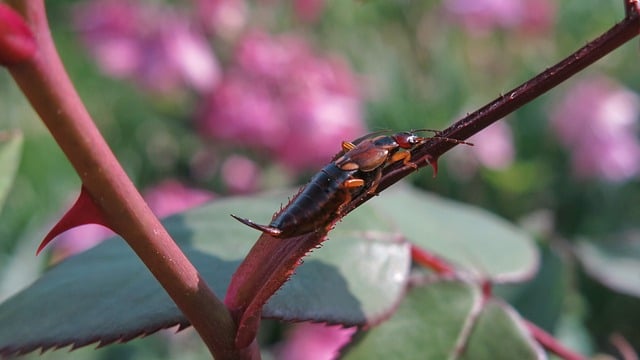Earwigs, drawn to moisture and dark spaces, invade homes seeking shelter. Effective earwig pest control involves understanding their habitat and taking proactive measures like reducing humidity, sealing entry points, and maintaining cleanliness. Natural solutions using essential oils (peppermint, lemon, lavender) and planting herbs (mint, basil, marigolds) repel them without harsh chemicals. Eco-friendly strategies include creating an unappealing environment with proper ventilation, sealing doors/windows, and introducing beneficial insects like spider bugs or nematodes. Regular monitoring with sticky traps complements these efforts for successful long-term earwig pest control.
“Tired of dealing with earwig infestations? Discover eco-friendly solutions for effective, long-term earwig prevention. This comprehensive guide breaks down the behavior and habitat of these pests, explores natural deterrents, and provides practical tips for implementation. Learn about innovative, sustainable methods to combat earwigs without harmful chemicals, ensuring a safer, more environmentally conscious home. Master earwig pest control with our expert advice.”
Understanding Earwigs: Behavior and Habitat
Earwigs, despite their intimidating name, are small insects that primarily feed on organic matter and plant debris. They are often considered a nuisance due to their tendency to invade homes and other buildings in search of moisture and shelter. Understanding earwig behavior is the first step towards effective earwig pest control. These insects are most active at night and prefer dark, humid spaces like basements, bathrooms, and crawl spaces. They are attracted to moisture sources and often enter through tiny cracks or gaps around pipes, windows, and doors.
Knowing their habitat allows homeowners to take proactive measures. Implementing basic earwig prevention techniques involves reducing moisture levels in problem areas, sealing entry points with caulk or weatherstripping, and maintaining a clean and dry environment. Regular inspections, especially during humid seasons, can help identify potential entry points and ensure swift action for earwig pest control.
Natural Repellents and Deterrents
Earwigs, despite their harmless nature, can be a nuisance for many homeowners due to their peculiar behavior and presence in homes. Fortunately, there are several natural solutions that offer effective earwig pest control without resorting to harsh chemicals. These include essential oils like peppermint, lemon, and lavender, which have strong aromas that earwigs find unpleasant. Sprays or diluted oils can be used to create a protective barrier around entry points such as windowsills, doorframes, and vents.
Another natural deterrent is using certain plants known for their insect-repelling properties. For instance, growing mint, basil, or marigolds in your garden or near entryways can help keep earwigs at bay. These plants contain compounds that not only deter earwigs but also attract beneficial insects, promoting a healthier ecosystem around your home. Combining these natural methods can significantly reduce the need for chemical earwig pest control and foster a more sustainable living environment.
Eco-Friendly Methods for Long-Term Prevention
When it comes to eco-friendly methods for long-term earwig pest control, there are several natural solutions that can help keep these pests at bay without resorting to harmful chemicals. One effective approach is to create an environment that discourages earwigs from entering your space. This includes sealing gaps and cracks around doors and windows, ensuring proper ventilation, and maintaining a clean, clutter-free home, as earwigs are attracted to dark, moist spaces.
Using essential oils like peppermint, lavender, and cedarwood can also act as natural repellents. Sparing these scents around entry points and problem areas can deter earwigs from invading. Additionally, introducing beneficial insects like spider bugs or nematodes into your environment can help control the earwig population by feeding on them naturally. These organic methods not only reduce environmental impact but also promote a healthier, more sustainable living space.
Practical Tips for Implementing Effective Control Measures
Implementing effective earwig pest control requires a combination of strategic measures and eco-friendly practices. Start by sealing entry points such as cracks, gaps, and vents using caulk or weatherstripping to prevent these pests from finding their way indoors. Regularly clean and disinfect areas prone to earwig activity, paying close attention to corners, baseboards, and dark, moist spaces where they tend to hide. Maintain a tidy home by promptly addressing any food spills or crumbs, as earworms are attracted to organic matter.
Consider using natural repellents like mint, lavender, or citronella essential oils, which can be mixed with water and sprayed around entry points and infested areas. Planting these herbs around your property can also act as a deterrent. Additionally, introduce beneficial insects like nematodes or spiders, which feed on earwigs, into your environment to promote biological control. Regular monitoring using sticky traps can help track the success of these measures and guide further action if needed.
Earwigs can be a persistent pest, but adopting eco-friendly methods offers a sustainable solution for long-term earwig prevention. By understanding their behavior and habitat, we can implement natural deterrents and repellents to keep these insects at bay. Incorporating simple, practical tips into your daily routine allows for effective control while minimizing the use of harmful chemicals. With these eco-conscious strategies, you can reclaim your space from earwigs and maintain a healthier environment for both your home and the local ecosystem. Remember, when it comes to earwig pest control, natural solutions are the way forward.
